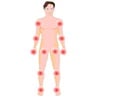A new review has categorically said that opoid drugs must not be taken for knee pain caused by osteoarthritis.
A new review has categorically said that opoid drugs must not be taken for knee pain caused by osteoarthritis.
"We found that pain reduction with opioid treatment was small to moderate. Increasing the dosage did not appear to result in further pain reduction," said lead review author Eveline Nüesch, a research fellow at the University of Bern in Switzerland. "However, patients taking opioids have large increases in risks of experiencing adverse effects and frequently stop taking opioids medications for this reason."The review appears in the latest issue of The Cochrane Library, a publication of the Cochrane Collaboration, an international organization that evaluates medical research. Systematic reviews draw evidence-based conclusions about medical practice after considering both the content and quality of existing medical trials on a topic.
"It is striking how little additional benefit patients with hip or knee pain can expect from taking opiates compared to placebo," said Nortin Hadler, M.D., a professor of medicine at the University of North Carolina at Chapel Hill and spokesperson for the American College of Rheumatology. "The advantage is arguably meaningful at best. However, the likelihood that unwanted effects are prominent is clearly meaningful."
Some common side effects of opioid use are nausea, constipation and, with long-term use, drug dependence and withdrawal symptoms.
Analyzing 10 studies comprising 2,268 patients, the reviewers compared the efficacy and safety of opioid pills and patches. Studies evaluated separately the use of oral codeine, fentanyl patches, oral morphine, oral oxycodone and oral oxymorphone in severe osteoarthritis.
The reviewers also looked at whether opioid type, mode of administration - pill or patch - or any other factors could explain differences in outcomes. "The effects of different types of opioids on pain relief and improvement of function appeared to be comparable," Nüesch said.
While opioids decreased pain and improved function, the benefit was small to moderate, and increasing the dose did not increase efficacy. Adverse events led to a high rate of discontinuation, making long-term use questionable.
The reviewers found no significant differences in the effects of the drugs according to pain-killing potency, daily dose, treatment duration or follow up.
They concluded that it is not advisable to use opioids routinely for these patients, even in the event of severe osteoarthritic pain. (Although the review excluded studies of the opiate tramadol, a 2006 Cochrane review of tramadol yielded similar findings.)
Hadler said that whatever therapeutic benefit patients can get from acetaminophen is "as good as it gets, and much better than any other option in terms of risk/benefit ratio and cost/effectiveness ratio." He said that opioids have no place in this clinical setting.
However, Roger Chou, M.D., associate professor of medicine at Oregon Health and Science University in Portland, had a different viewpoint: "Taking a broader perspective, NSAIDs and acetaminophen aren''t particularly effective for osteoarthritis, and other options are limited other than hip or knee replacement - which has its own risks and costs."
Chou added that it is not yet possible to generalize that potential harm from opioid treatment outweighs potential individual benefit. He said that more research could help enable clinicians "to better identify patients likely to benefit from opioids. We know responses vary, but at this time don''t have a good way to predict who will respond better than others."
Advertisement
RAS













